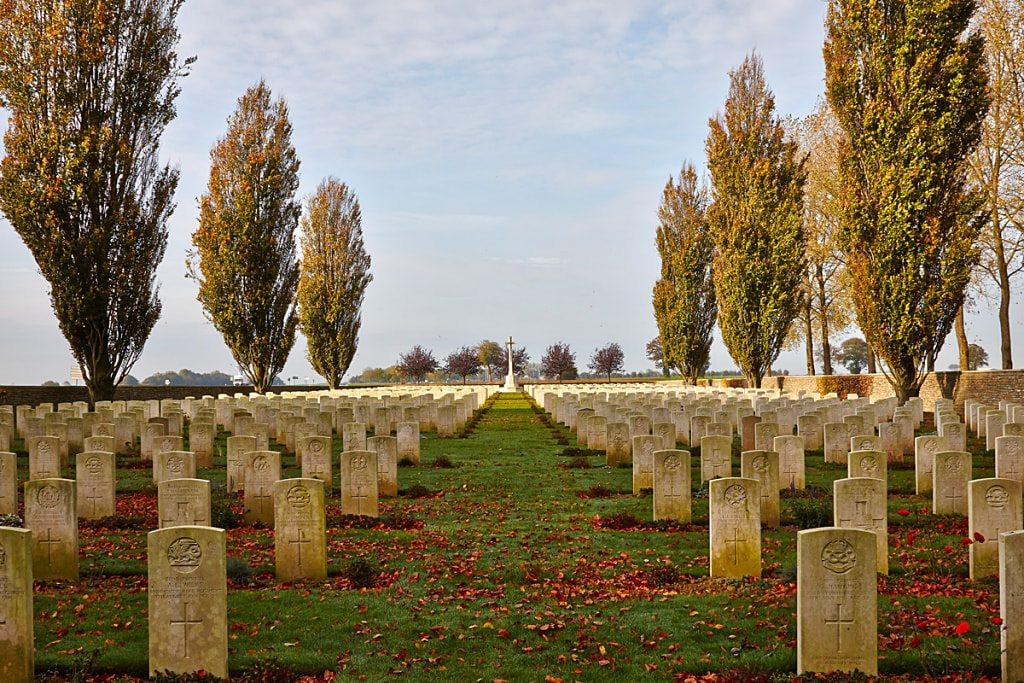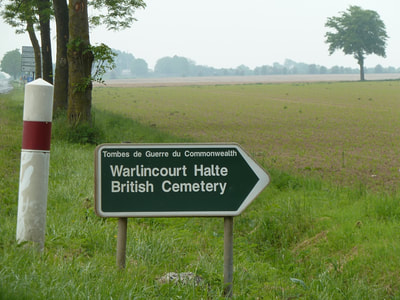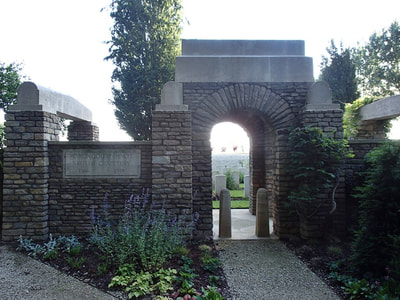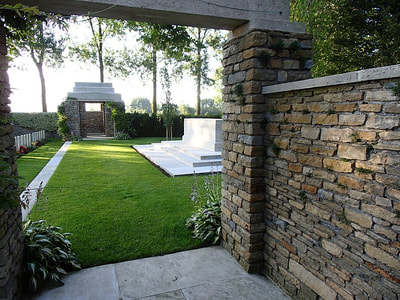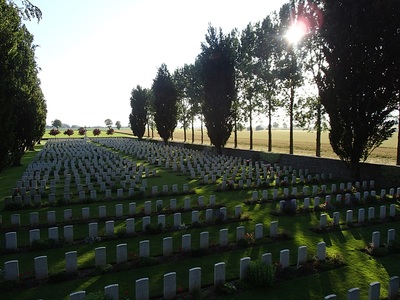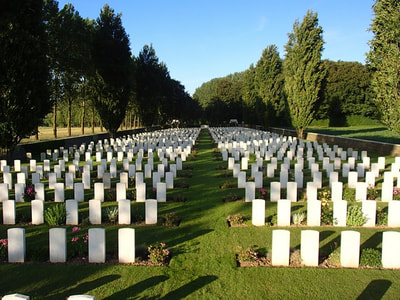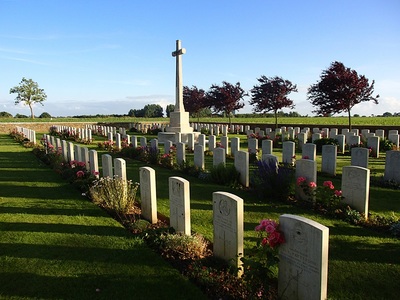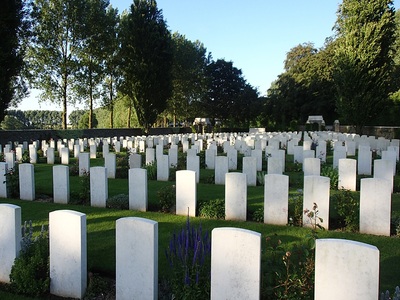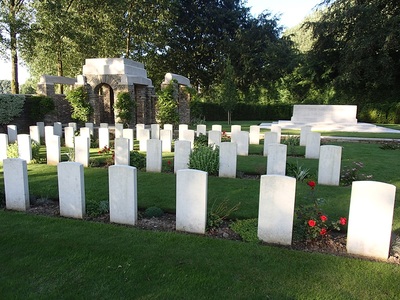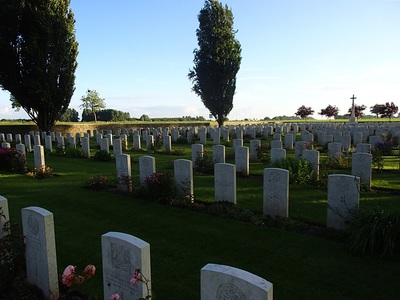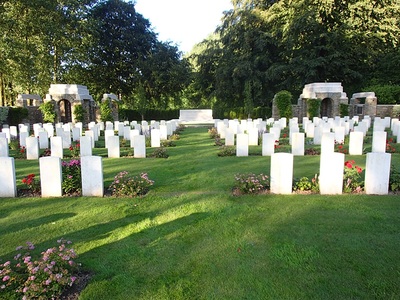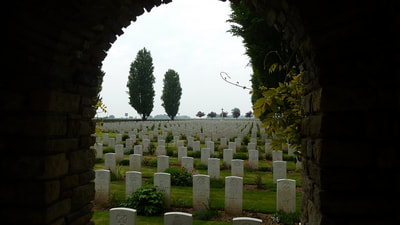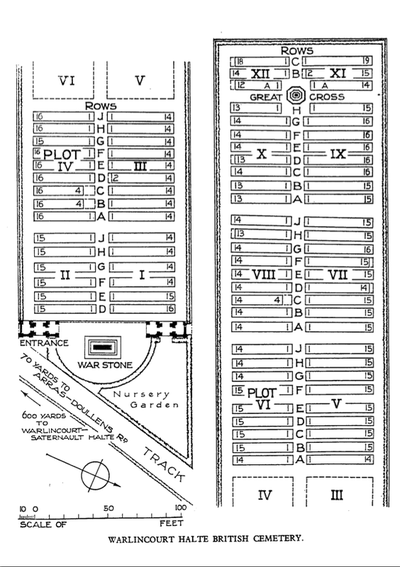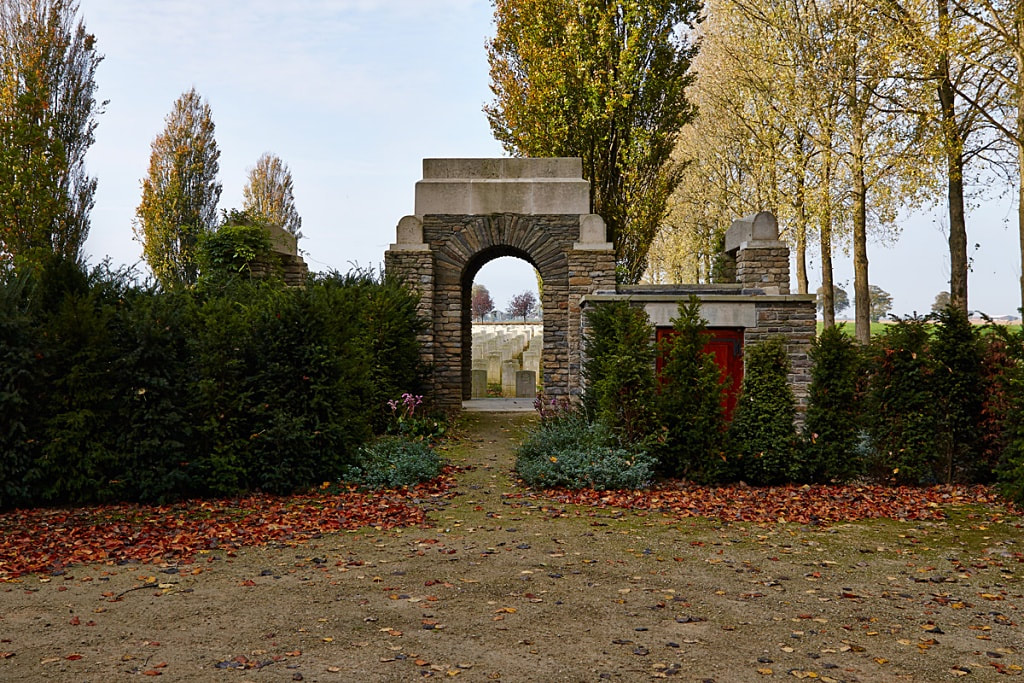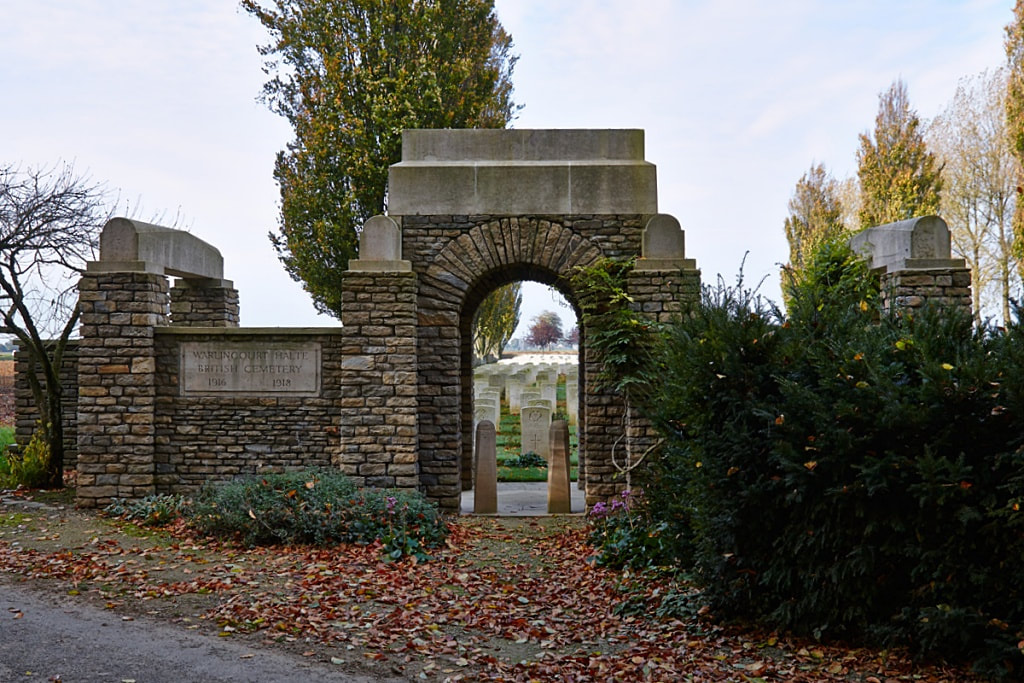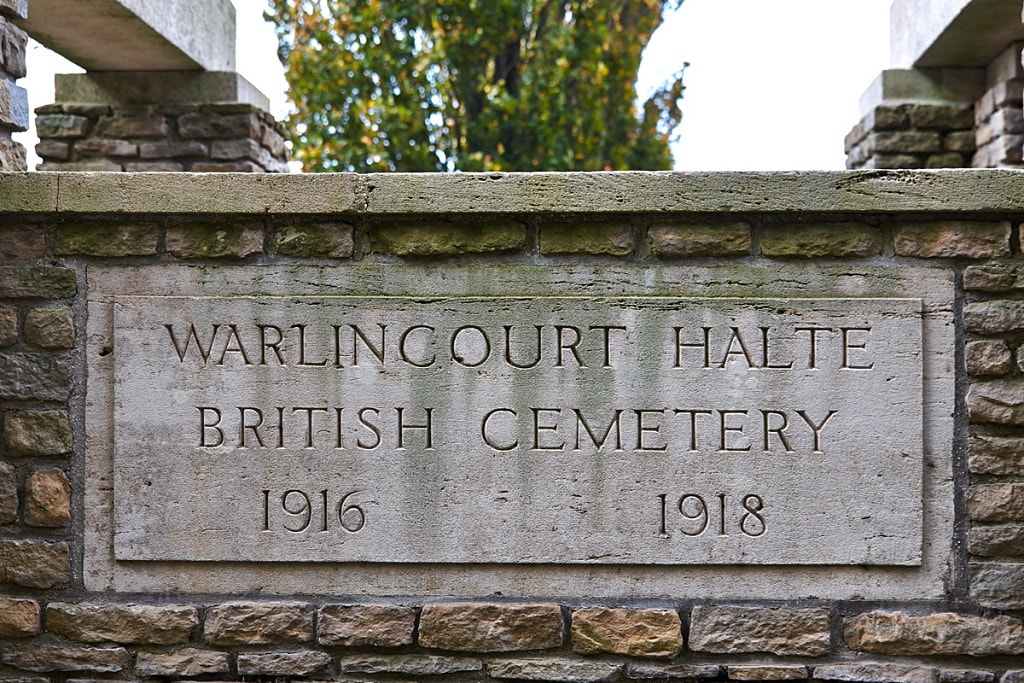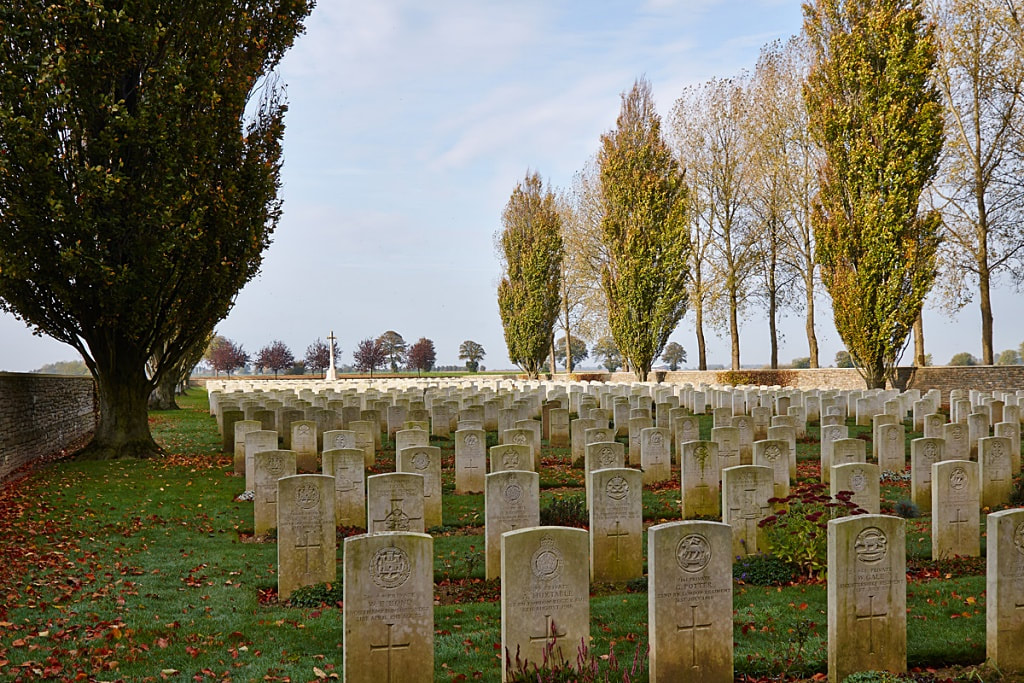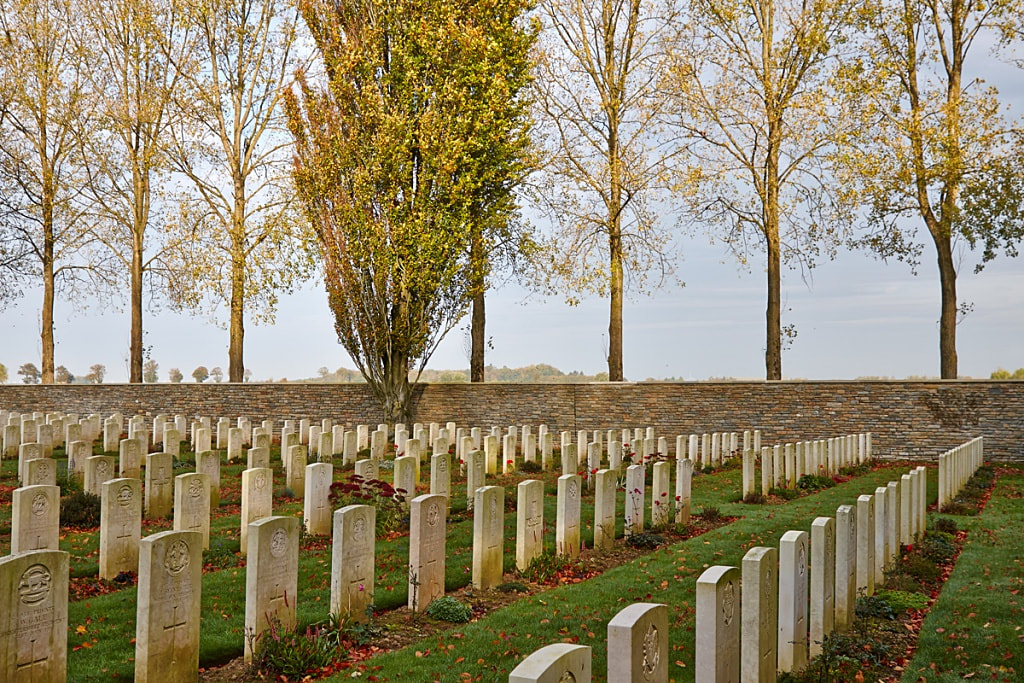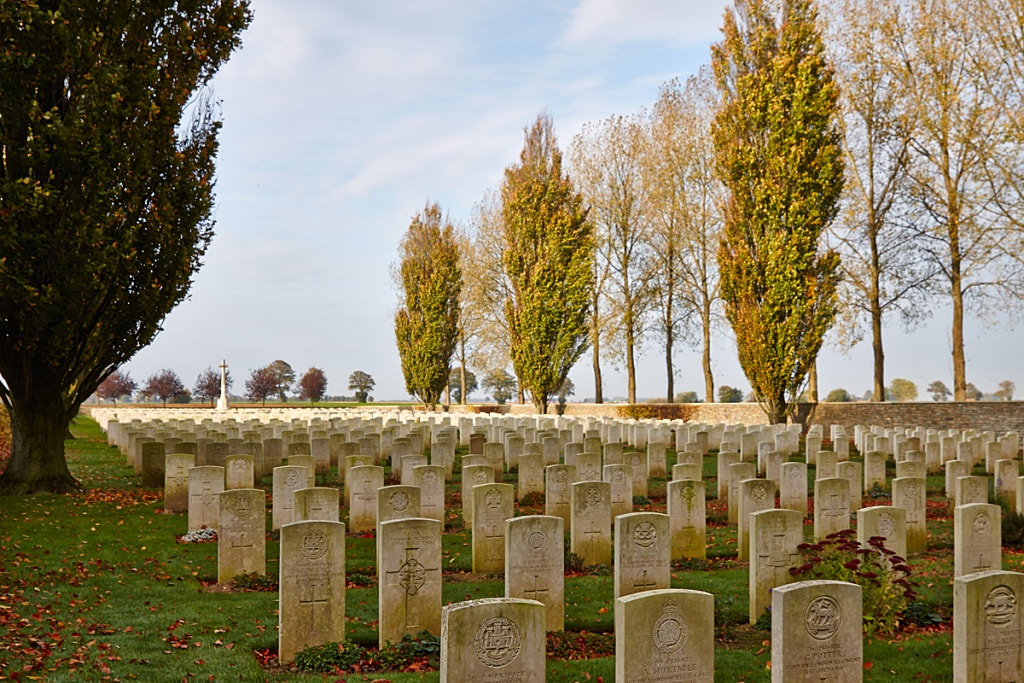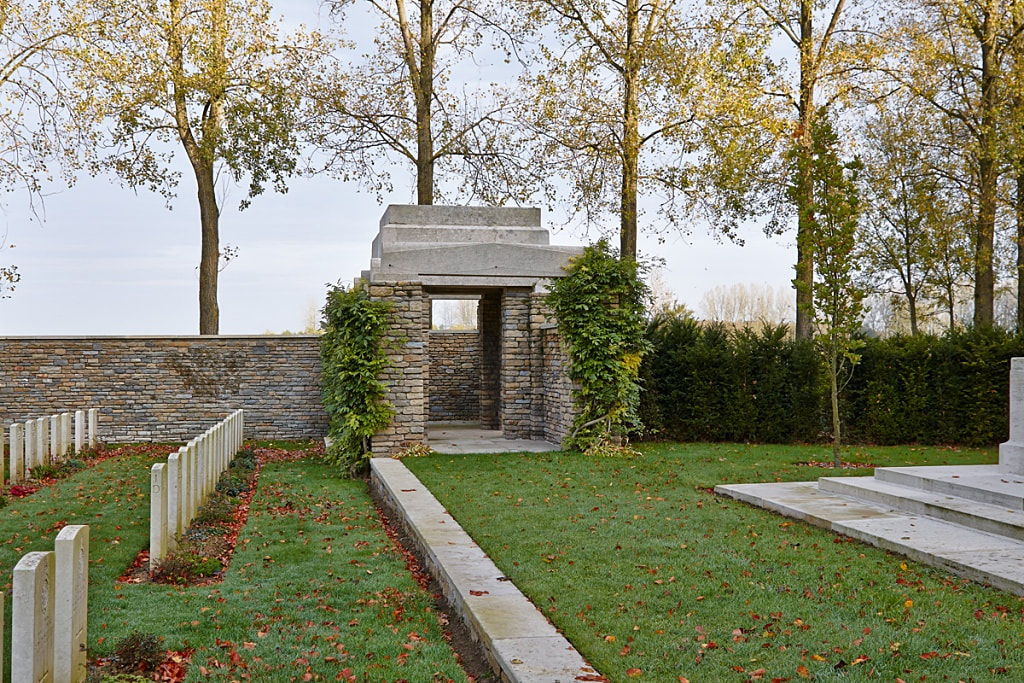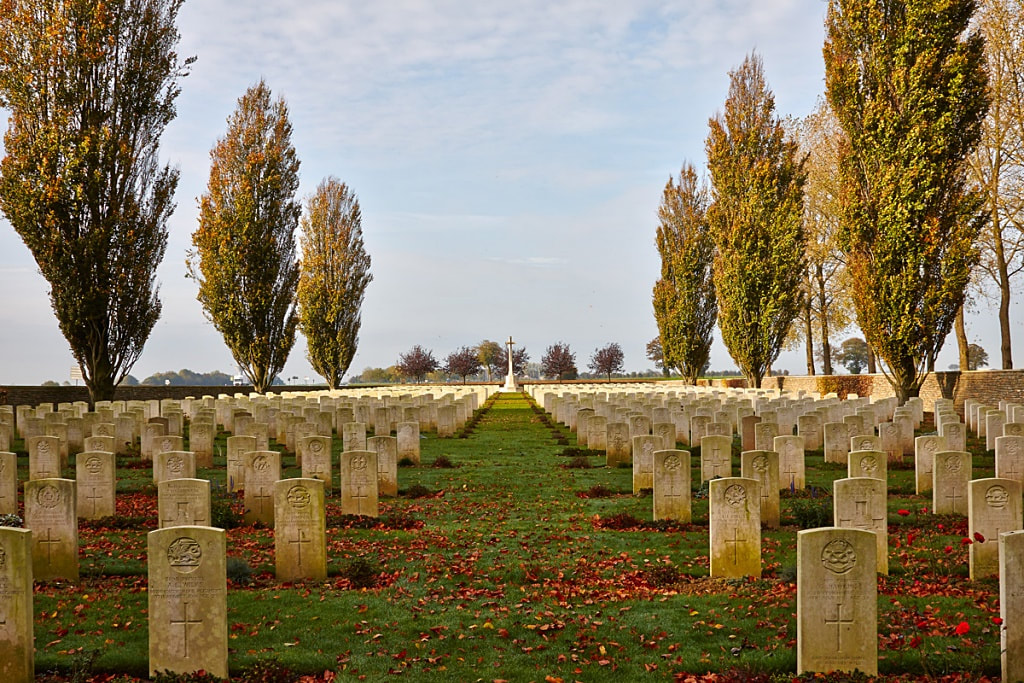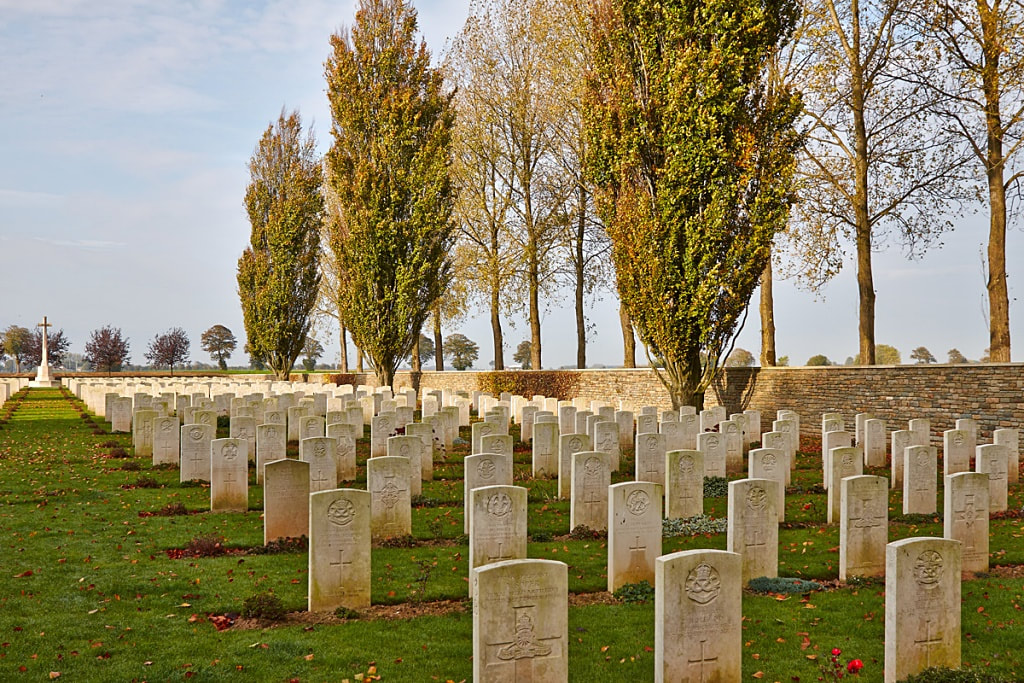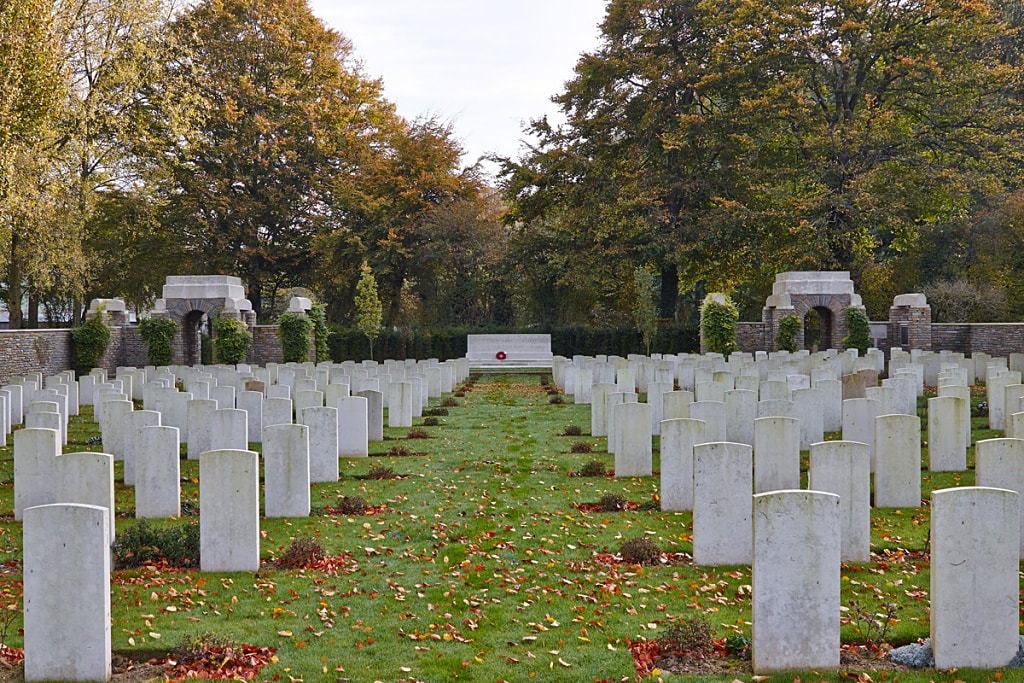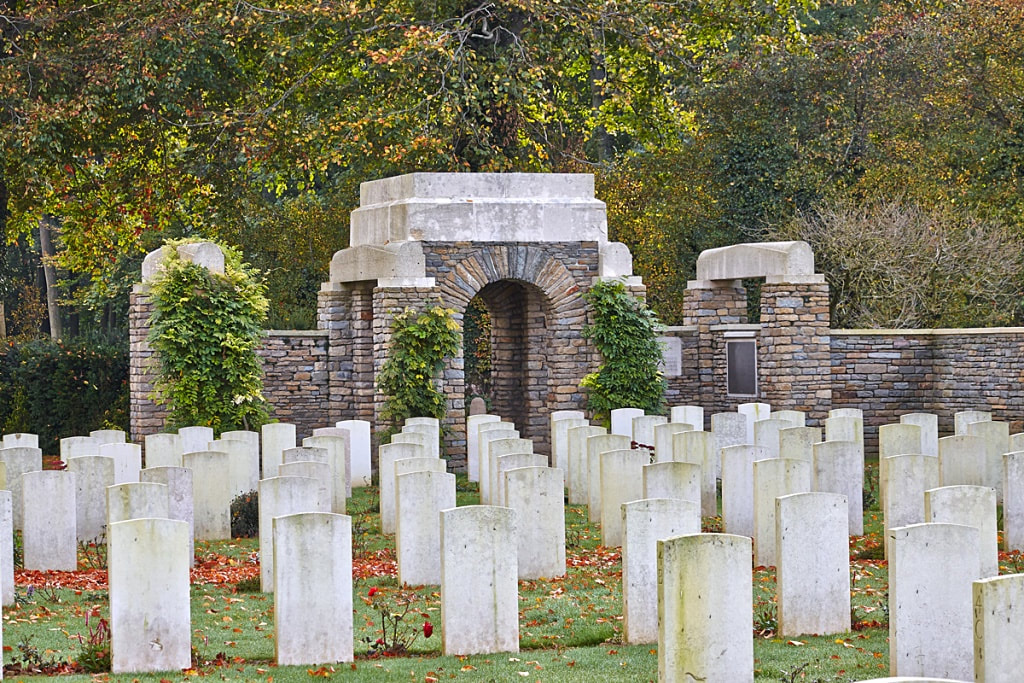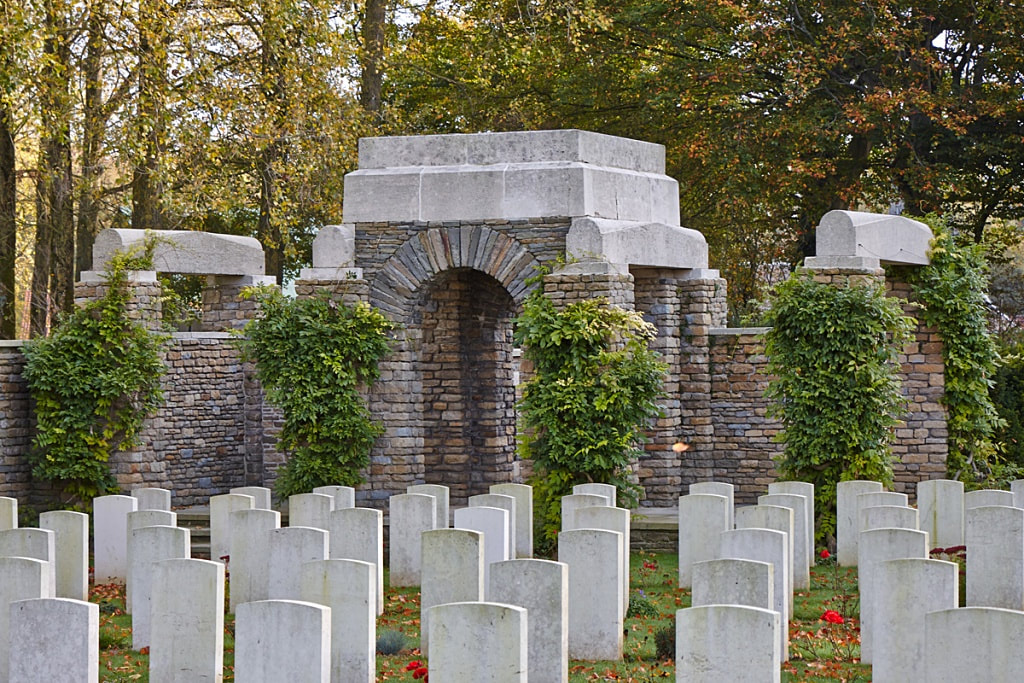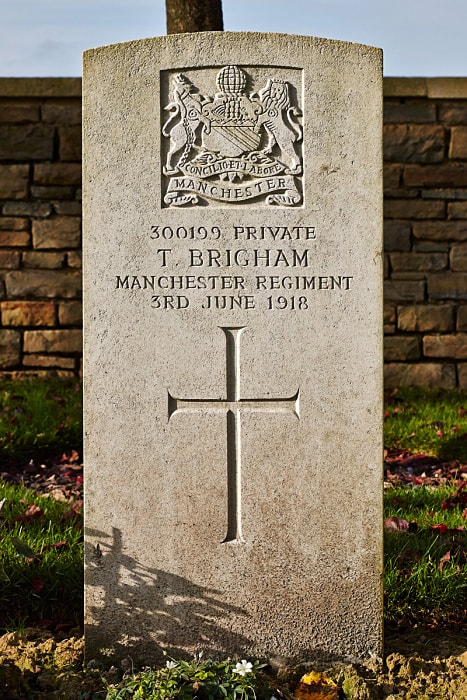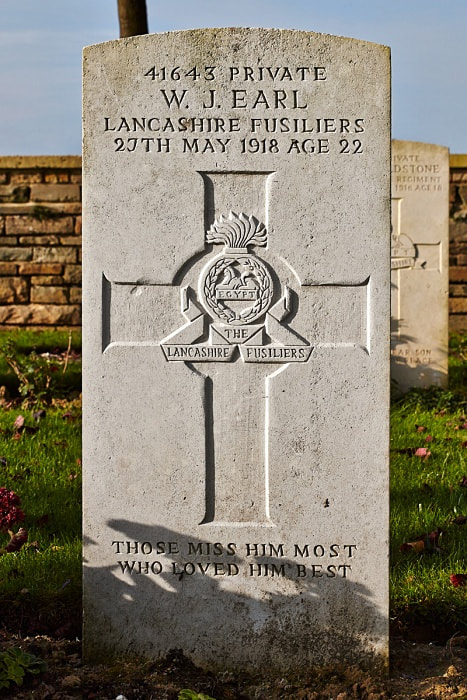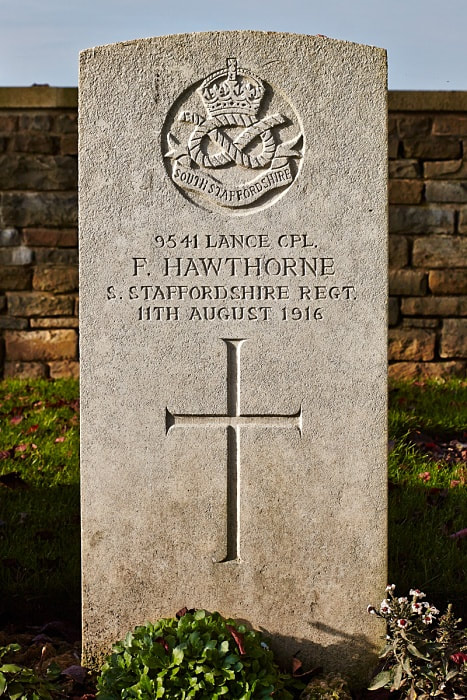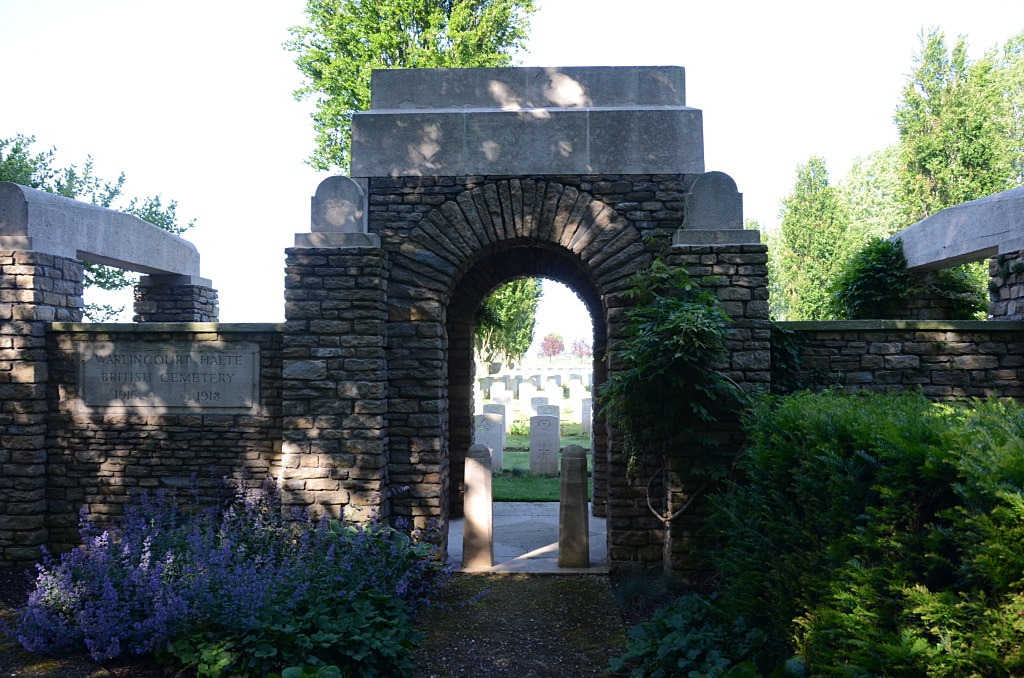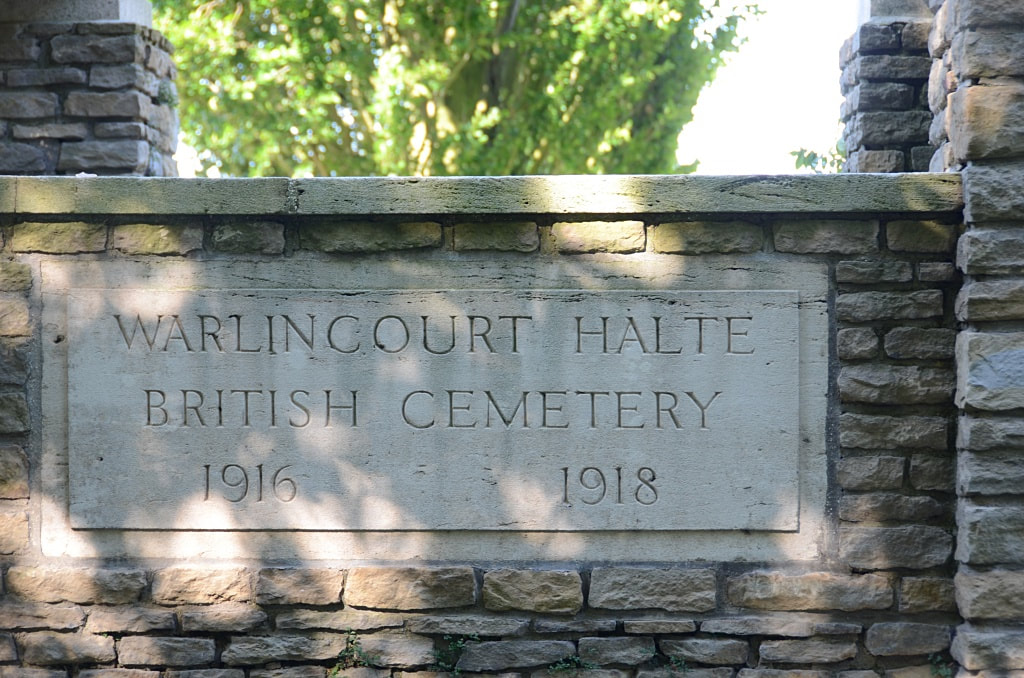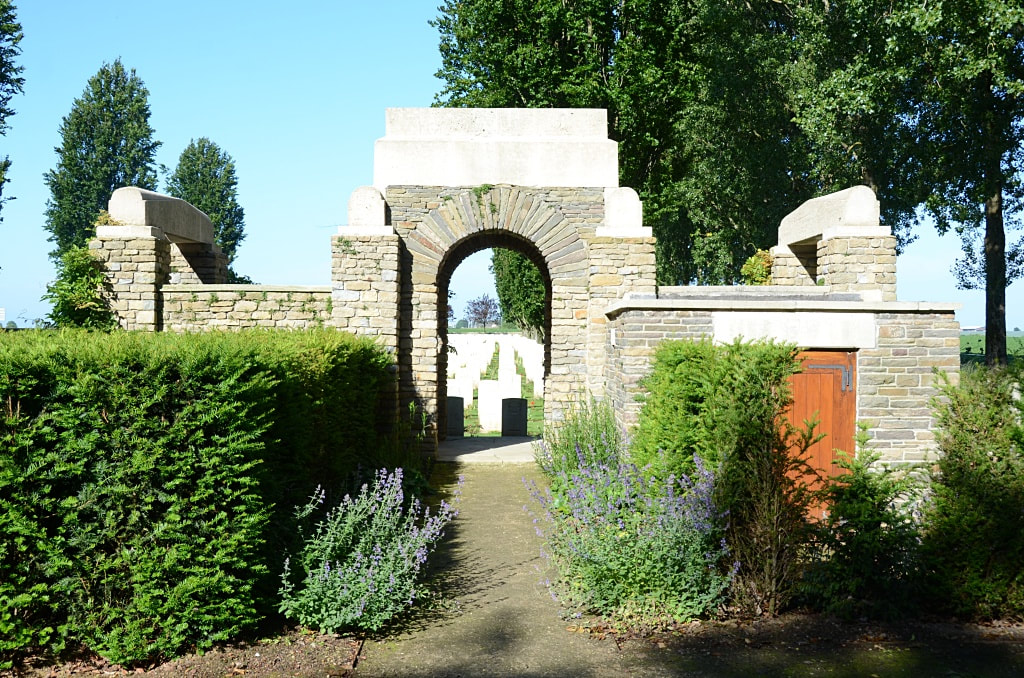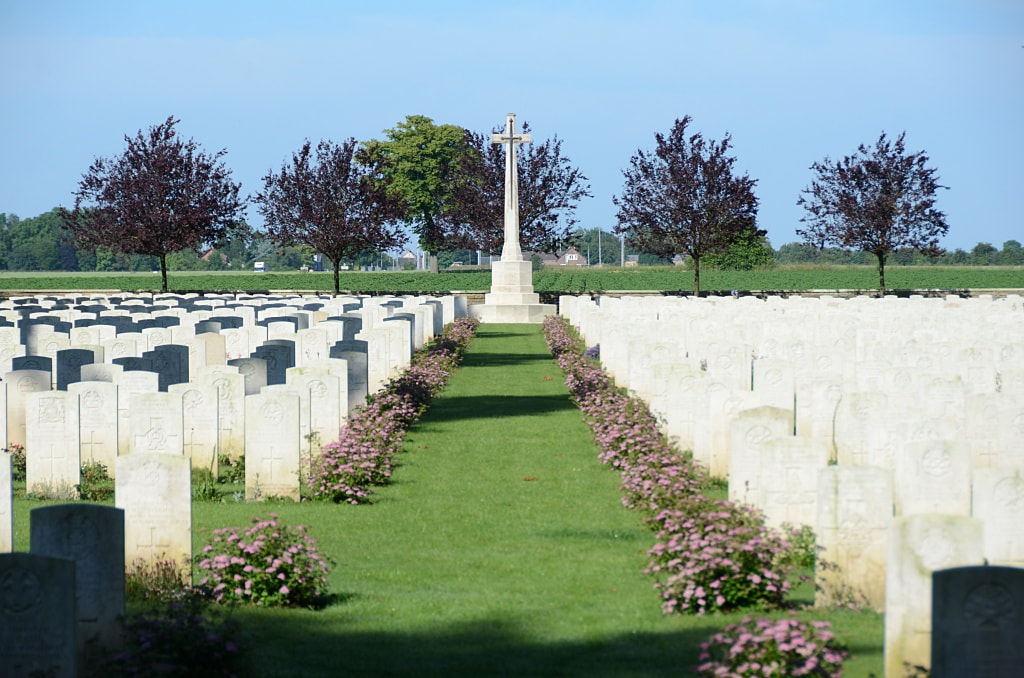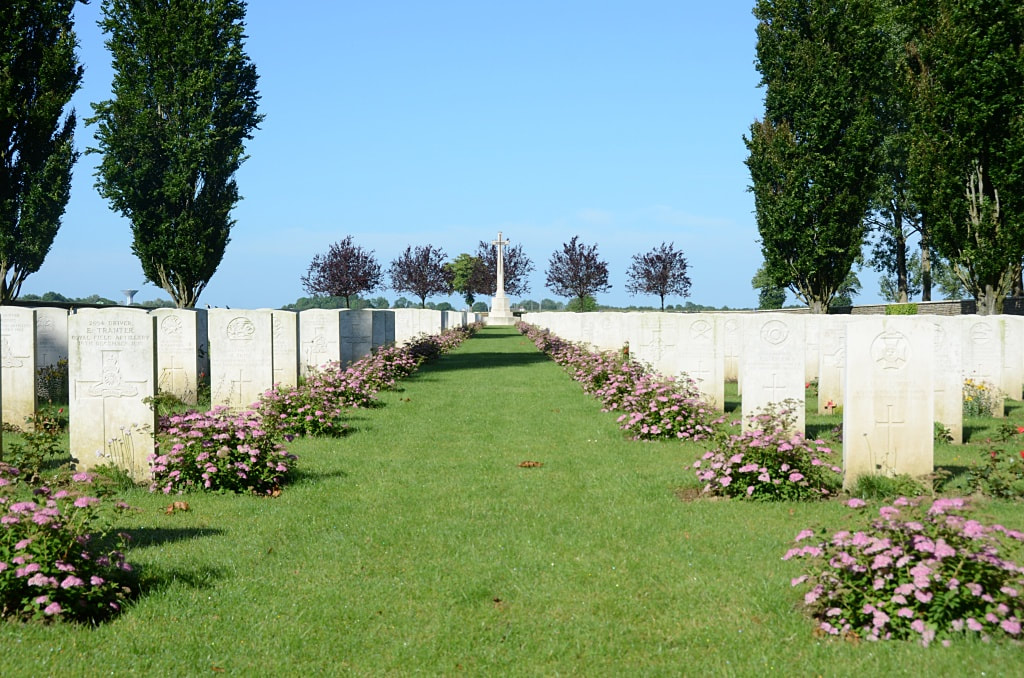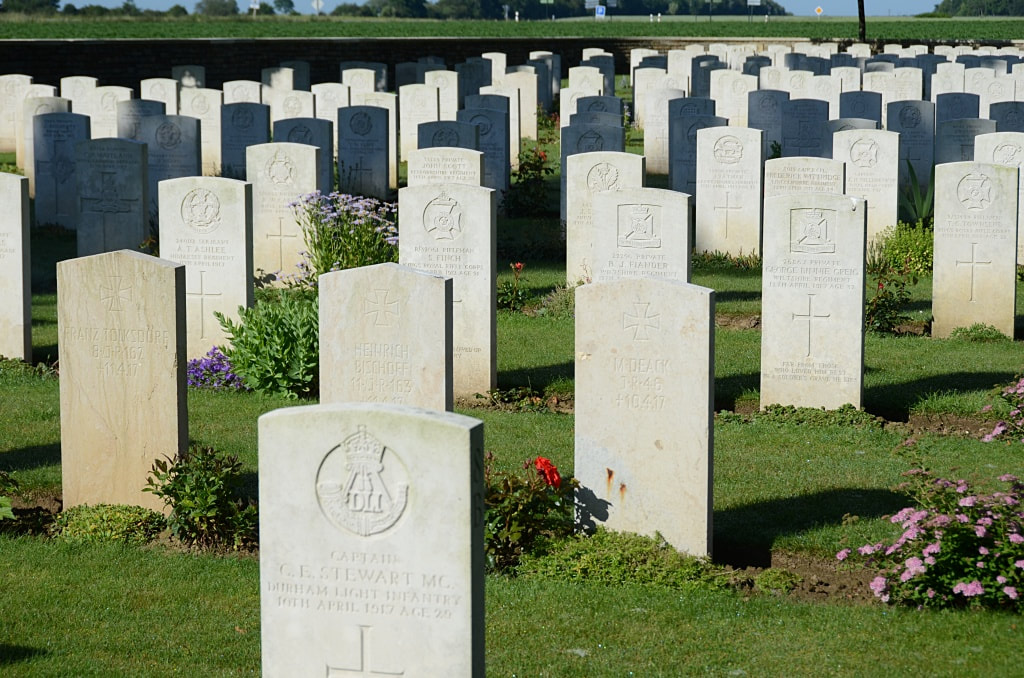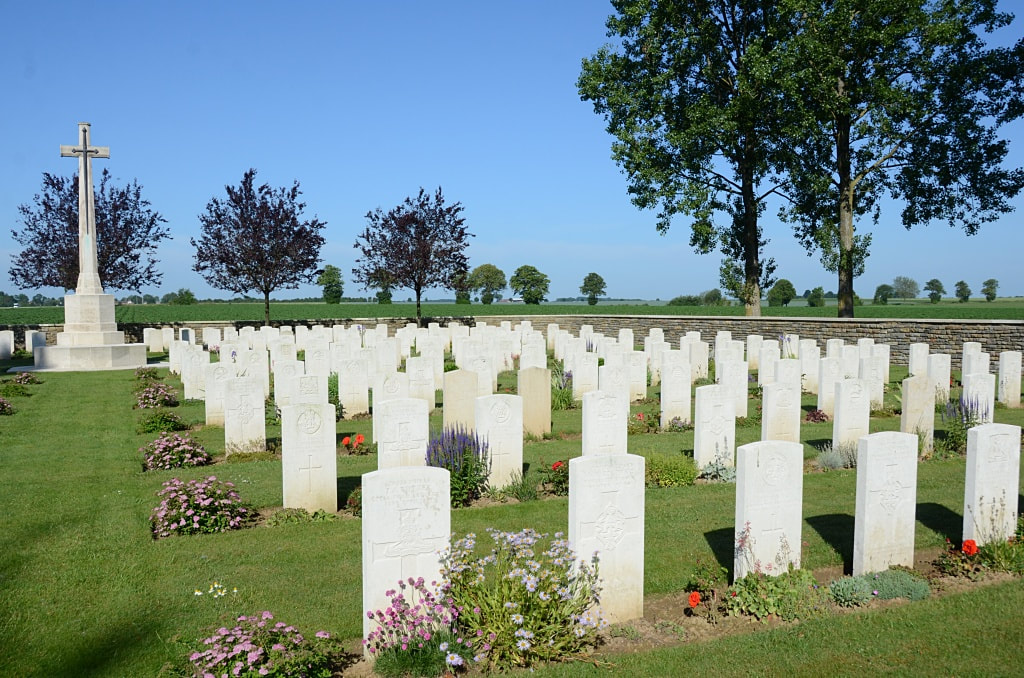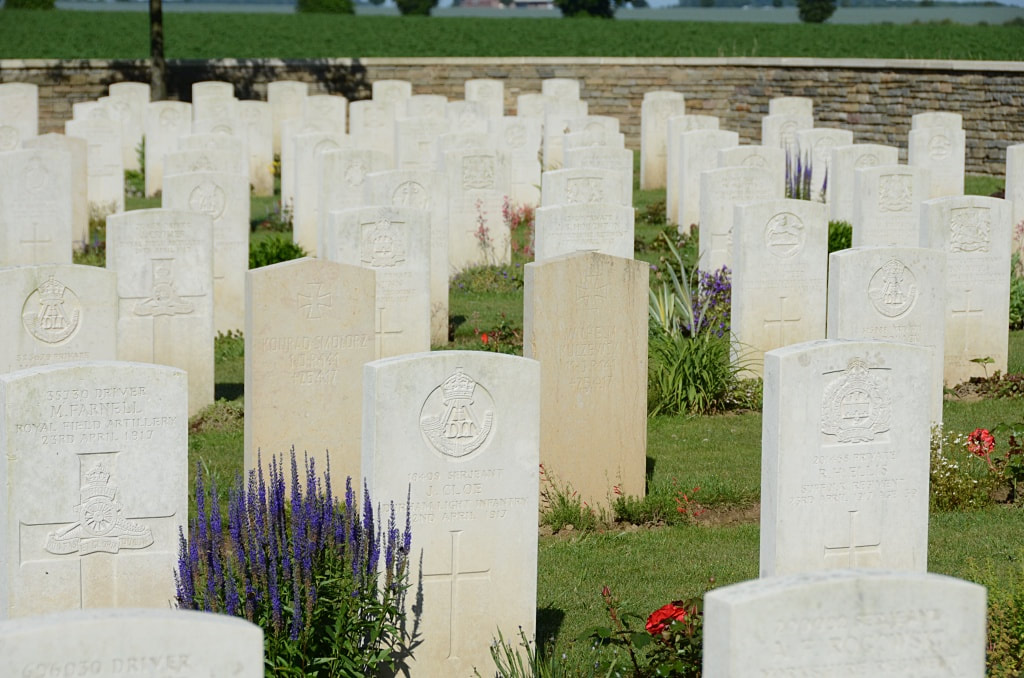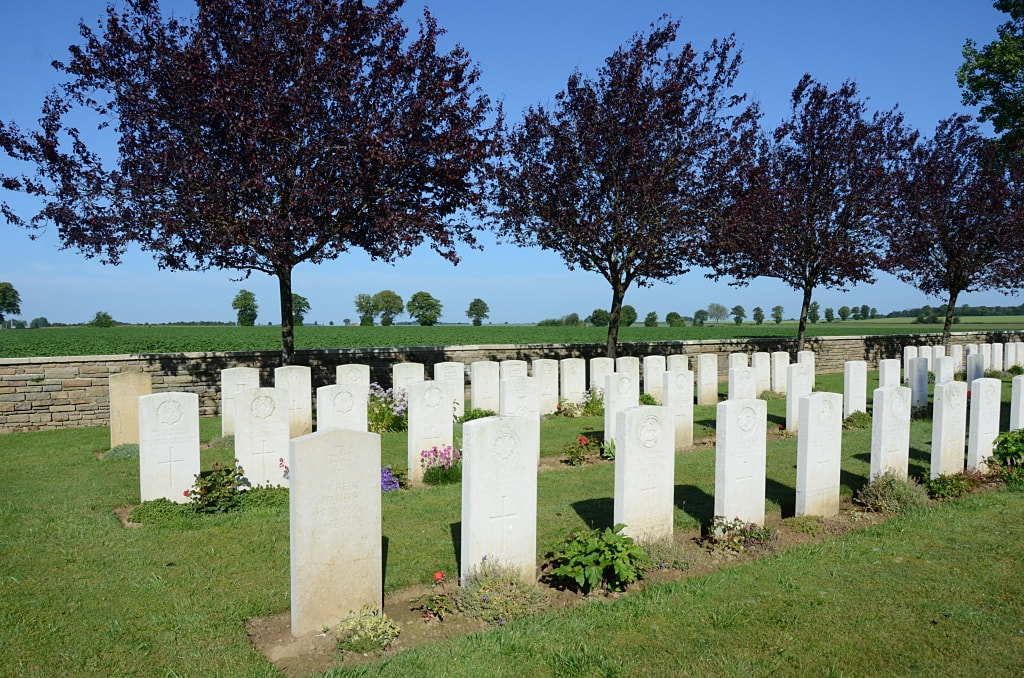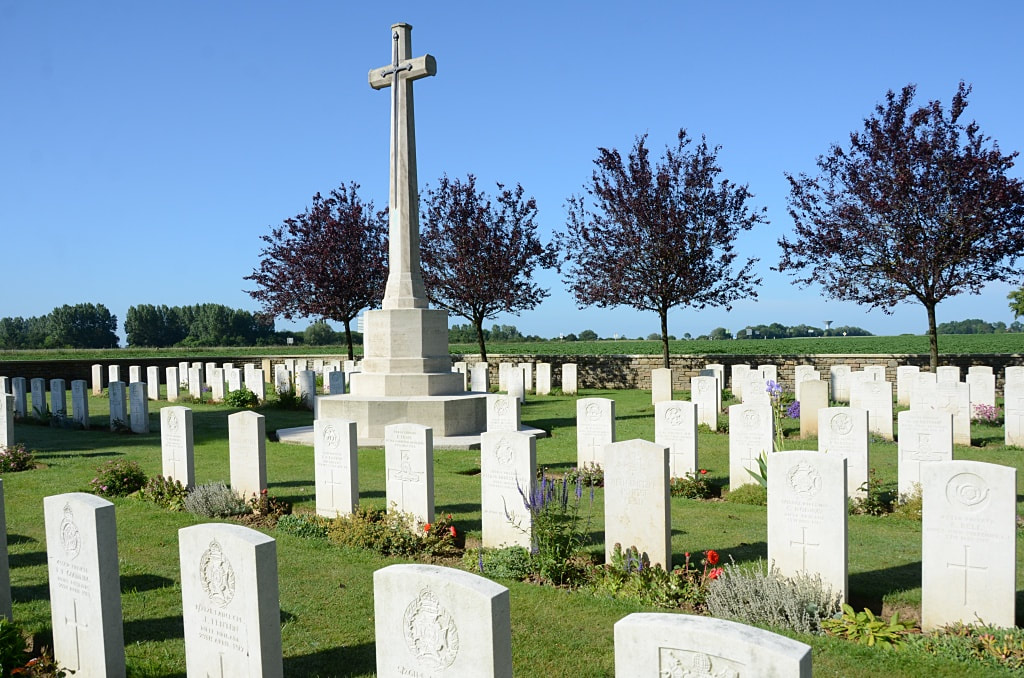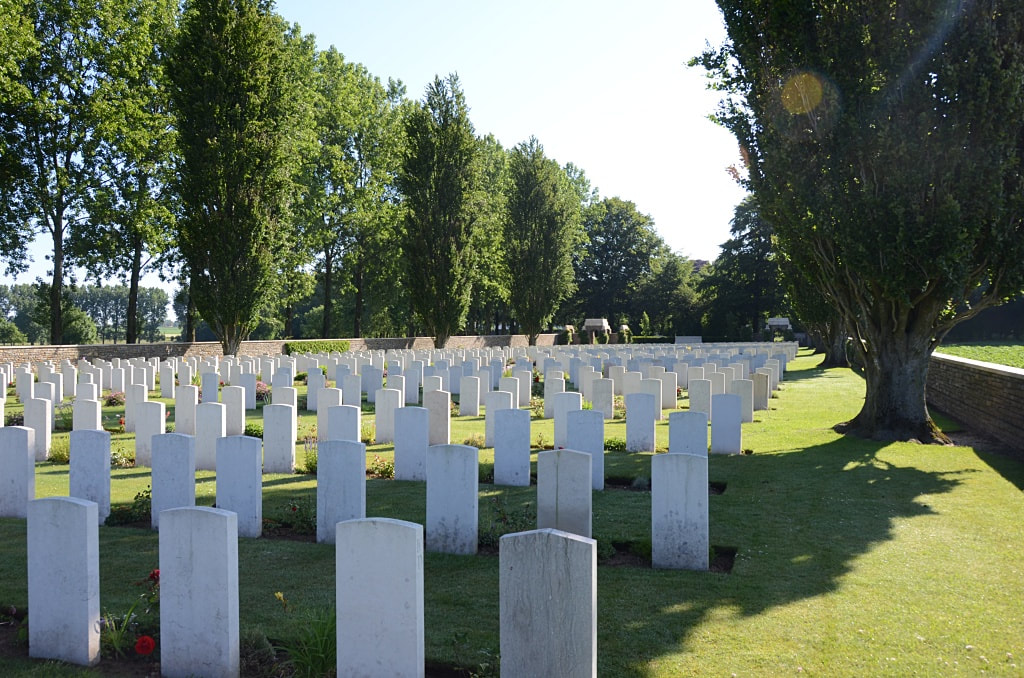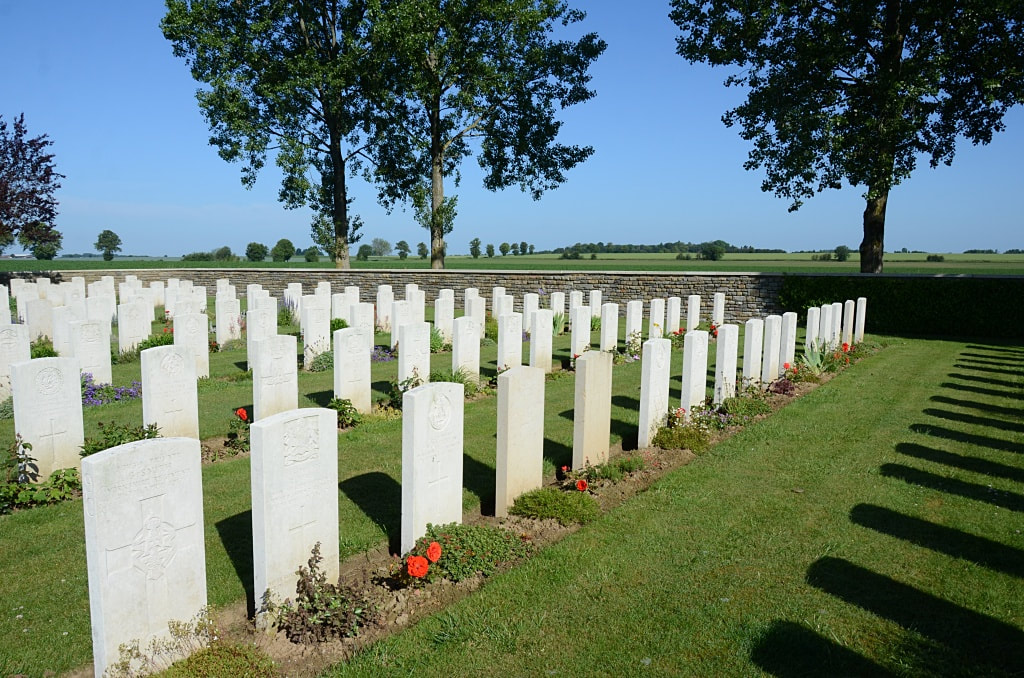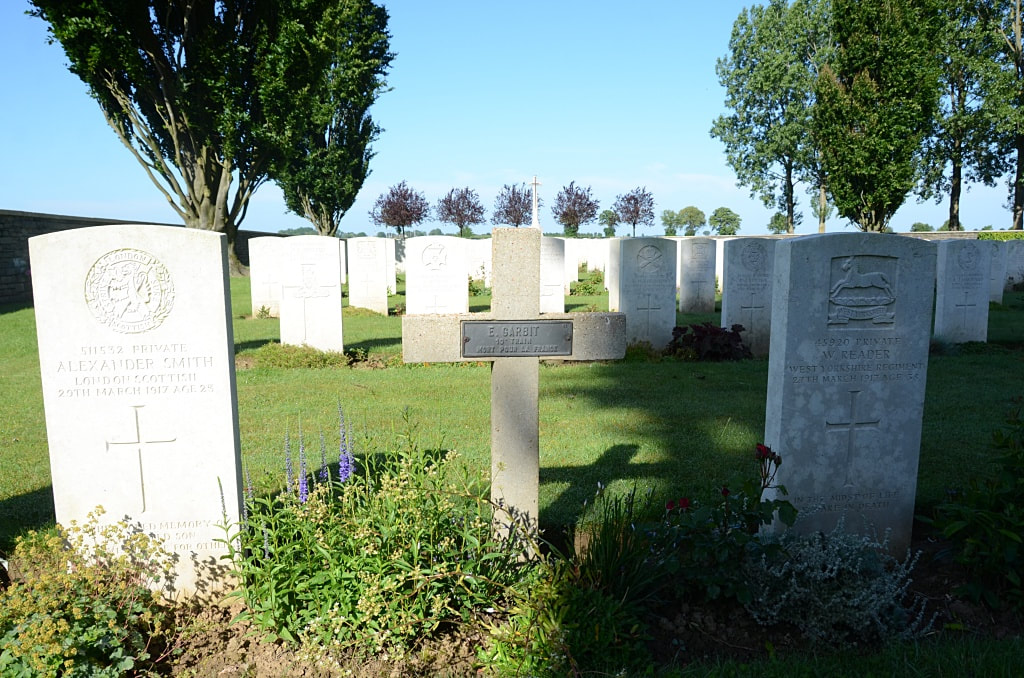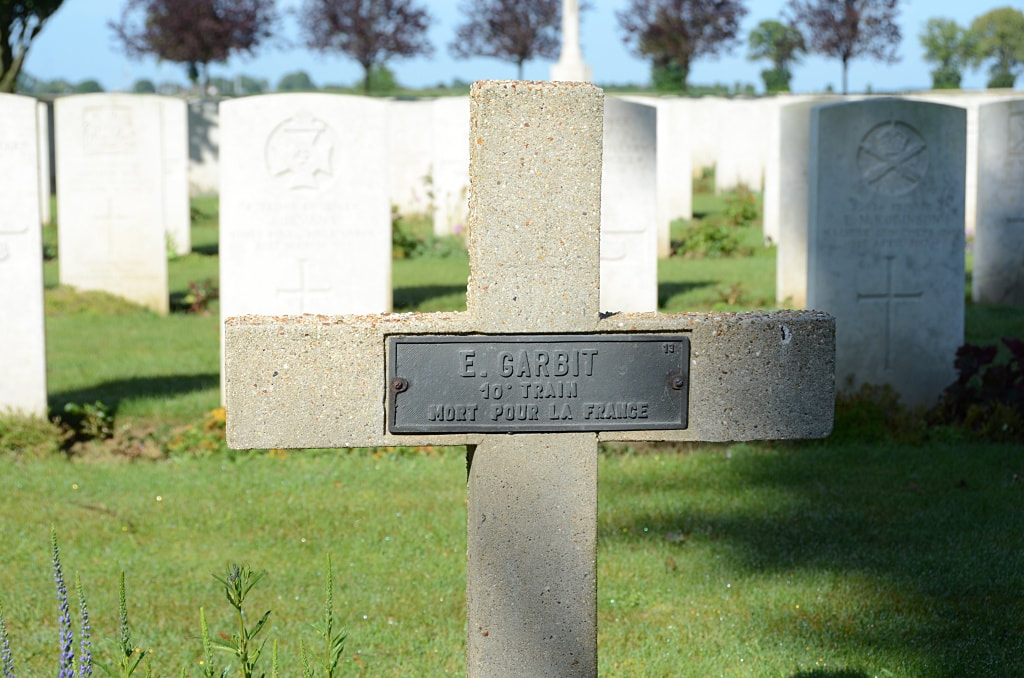WARLINCOURT HALTE BRITISH CEMETERY
Saulty
Pas De Calais
France
GPS coordinates: Latitude: 50.19835, Longitude: 2.51891
Location Information
Warlincourt and Saulty are villages on either side of the main road (N25) between Arras (22 kilometres) and Doullens (13 kilometres). Warlincourt Halte British Cemetery is situated just off the north side of the road. Large signs clearly indicate access 200 metres before the site coming from either direction.
The site of the cemetery was chosen in May 1916. It was used from June 1916 to May 1917 by the 20th and 43rd Casualty Clearing Stations, in February 1917 by the 1/1st South Midland, and from April to June 1917 by the 32nd. The whole of plots VII, VIII, IX and X were filled in April and May 1917, the months of the Battles of Arras. From June 1917, the cemetery was practically unused until the fighting of May and June 1918, when field ambulances buried in it. After the Armistice the cemetery was increased by graves brought in from the following small military cemeteries:-
GAUDIEMPRE MILITARY CEMETERY, which contained 33 British graves, and lay on the South-East side of the village of Gaudiempre near the road to St. Amand. It was used from June 1916 to April 1918, chiefly by the Field Ambulances of the Divisions in the sector.
Couturelle Communal Cemetery Extensions, which contained 10 British graves. It was East of the village, on the South side of the road to Gombremetz. It was used by Field Ambulances and fighting units from April 1916 to February 1917.
La Herliere Military Cemetery, which lay between the villages of La Herliere and Larbret. It was used from June 1916 to January 1917, by Field Ambulances and fighting units, and contained 13 British graves.
The cemetery now contains 1,265 Commonwealth burials of the First World War. There are also 29 German and two French war graves.
Total Burials: 1,296.
Identified Casualties: United Kingdom 1,254, Germany 27, Canada 4, France 2. Total 1,287.
Unidentified Casualties: 9.
The cemetery was designed by Charles Holden See Below
(Attributed by CWGC & by Holden’s biographer(!) to Holden. But Geurst (p438) conclusively proves that Lutyens & Goldsmith were responsible, for the design was found in the papers of Lutyen’s garden architect Gertrude Jekyll — who never worked for Holden. Moreover, the shelters (well shown on the website) are exactly like those in several cemeteries by Lutyens & Goldsmith, e.g., Achiet le Grand; Bagneux; Albert CCE; Douchy les Ayette — & nothing like them can be seen in the work of Holden)
Dedications
267546 Private John H. Rayner, 6th Bn. Northumberland Fusiliers, 16th April 1917, aged 27. Plot VIII. H. 2. Son of J. H. Rayner, of 499, Mansfield Rd., Sherwood, Nottingham. Remembered with honour by Doreen Mundy
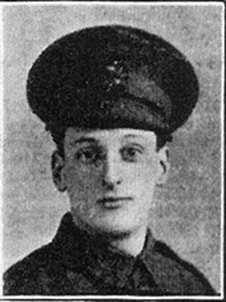
2738 Rifleman
Sidney George Barnes
C Company. London Regiment (Queen Victoria's Rifles)
4th July 1916, aged 22.
Plot I. G. 14
Son of James Quick Barnes, and Phyllis Barnes, of 27, Endymion Rd., Brixton Hill, London.
Sidney George Barnes
C Company. London Regiment (Queen Victoria's Rifles)
4th July 1916, aged 22.
Plot I. G. 14
Son of James Quick Barnes, and Phyllis Barnes, of 27, Endymion Rd., Brixton Hill, London.
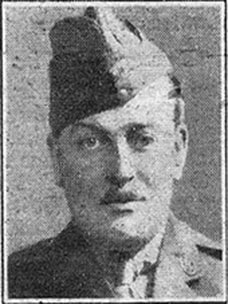
Second Lieutenant
Geoffrey Chasemore Burnand
48th Squadron, Royal Flying Corps
7th April 1917
Plot V. J. 5.
Son of the late Graham Burnand and of Elizabeth Frances Burnand, of Knockacur, Doneraile, Co. Cork. M.A., M.I.C.E. Left the Argentine to join up. Native of Worth, Sussex.
Geoffrey Chasemore Burnand
48th Squadron, Royal Flying Corps
7th April 1917
Plot V. J. 5.
Son of the late Graham Burnand and of Elizabeth Frances Burnand, of Knockacur, Doneraile, Co. Cork. M.A., M.I.C.E. Left the Argentine to join up. Native of Worth, Sussex.
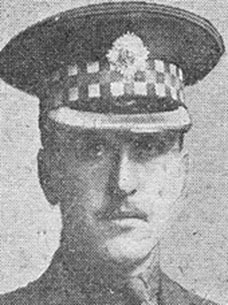
Second Lieutenant
Rupert Maurice Chamberlain
2nd Bn. Scots Guards
20th May 1918, aged 20.
Plot XII. B. 9
Son of Dunstan and Louisa Chamberlain, of Royal Palace Hotel, Kensington, London.
Rupert Maurice Chamberlain
2nd Bn. Scots Guards
20th May 1918, aged 20.
Plot XII. B. 9
Son of Dunstan and Louisa Chamberlain, of Royal Palace Hotel, Kensington, London.
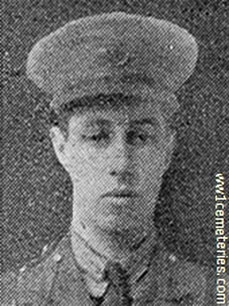
Second Lieutenant
George Godfrey Gray
5th Bn. Oxford and Bucks Light Infantry
10th April 1917, aged 22.
Plot VIII. B. 4.
Son of George Godfrey Gray and Marion Gray, of 33, Wellington Square, Hastings.
George Godfrey Gray
5th Bn. Oxford and Bucks Light Infantry
10th April 1917, aged 22.
Plot VIII. B. 4.
Son of George Godfrey Gray and Marion Gray, of 33, Wellington Square, Hastings.
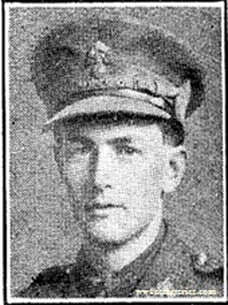
Lieutenant
D. W. L. Jones
3rd Bn. London Regiment (Royal Fusiliers)
1st July 1916, aged 21.
Plot II. D. 2.
Son of the Rev. Canon David Jones and Katharine Edwards Jones, of Tregarth, Penmaenmawr, Carnarvonshire.
D. W. L. Jones
3rd Bn. London Regiment (Royal Fusiliers)
1st July 1916, aged 21.
Plot II. D. 2.
Son of the Rev. Canon David Jones and Katharine Edwards Jones, of Tregarth, Penmaenmawr, Carnarvonshire.
Images in this gallery © Geerhard Joos
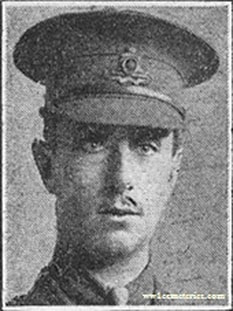
Lieutenant
John Herbert Morris
Royal Flying Corps, 49th Sqdn. and Royal Horse Artillery
6th March 1918, aged 19.
Plot XI. B. 15.
Son of Alfred and Kathleen Mary Emily Morris, of 4, Cadogan Square, London.
John Herbert Morris
Royal Flying Corps, 49th Sqdn. and Royal Horse Artillery
6th March 1918, aged 19.
Plot XI. B. 15.
Son of Alfred and Kathleen Mary Emily Morris, of 4, Cadogan Square, London.
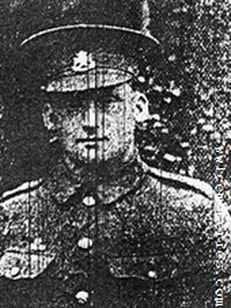
2872 Corporal
Albert Ernest Paling
1st/8th Bn. Sherwood Foresters (Notts and Derby Regiment)
14th July 1916, aged 20.
Plot I. H. 11.
Son of John and Annie Paling, of Constance Villa, Southwell, Notts.
Albert Ernest Paling
1st/8th Bn. Sherwood Foresters (Notts and Derby Regiment)
14th July 1916, aged 20.
Plot I. H. 11.
Son of John and Annie Paling, of Constance Villa, Southwell, Notts.
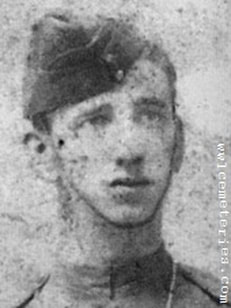
SR/10050 Private
Harold Cubiss Partridge
6th Bn. Leicestershire Regiment
4th May 1917, aged 24.
Plot X. F. 2.
Son of Harry and Mary Partridge, of 8, Ratcliffe Rd., Loughborough, Leicestershire.
Harold Cubiss Partridge
6th Bn. Leicestershire Regiment
4th May 1917, aged 24.
Plot X. F. 2.
Son of Harry and Mary Partridge, of 8, Ratcliffe Rd., Loughborough, Leicestershire.
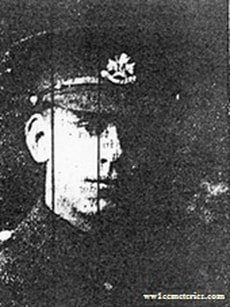
2857 Private
G. Talbot
1st/8th Bn. Sherwood Foresters (Notts and Derby Regiment)
6th July 1916, aged 20.
Plot II. E. 5.
Son of Kate Talbot, of Crab Lane, North Muskham, Newark, and the late Fred Talbot.
G. Talbot
1st/8th Bn. Sherwood Foresters (Notts and Derby Regiment)
6th July 1916, aged 20.
Plot II. E. 5.
Son of Kate Talbot, of Crab Lane, North Muskham, Newark, and the late Fred Talbot.
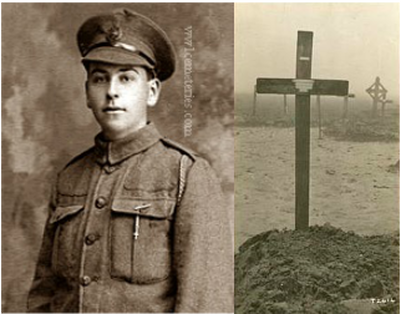
S/30365 Rifleman
Thomas Newberry
9th Bn. Rifle Brigade
5th May 1917
Plot IX. G. 1.
Thomas Newberry
9th Bn. Rifle Brigade
5th May 1917
Plot IX. G. 1.
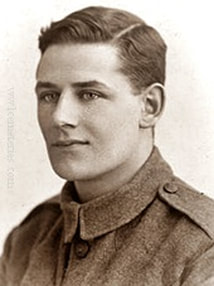
390521 Serjeant
Walter Harold Servante
"B" Coy. London Regiment (Queen Victoria's Rifles)
16th April 1917, aged 26.
Plot VII. H. 8.
Son of Robert and Amelia Servante, of London. Enlisted September 1914.
Died of wounds received during the Battle of Arras on 14th April 1917.
Walter Harold Servante
"B" Coy. London Regiment (Queen Victoria's Rifles)
16th April 1917, aged 26.
Plot VII. H. 8.
Son of Robert and Amelia Servante, of London. Enlisted September 1914.
Died of wounds received during the Battle of Arras on 14th April 1917.
Shot at Dawn:
300199 Private Thomas Brigham, 1st/10th Bn. Manchester Regiment, executed for desertion 3rd June 1918, aged 22. Plot 11. C. 15. Son of Thomas Brigham, of 57, Middlewood Street, Harpurley, Manchester, Lancs. He had enlisted before the war, & served in Gallipoli. Transferred to the Western Front in 1917, Brigham deserted twice, receiving sentences that included a suspended one of death; & in 1918, repeated the offence. (Putkowski,p.246)
41643 Private William J. Earl, 1st/7th Bn. Lancashire Fusiliers, executed for desertion 27th May 1918, aged 22. Plot 12. B. 10. Son of George and Lillian Earl, of 14, Earl St., Lower Broughton, Manchester. He absented himself from his battalion in April 1918 when they were serving on the Somme.
(Putkowski,pp.245-246)
9541 Lance Corporal Frederick Hawthorne, 1st/5th Bn. South Staffordshire Regiment, executed for Cowardice 11th August 1916, aged 22. Plot 12. C. 8.
He enlisted in Sept 1914, landing in France in March 1915. His battalion took part on 1 July 1916 in an unsuccessful assault at Gommecourt that was intended as a diversion to Rawlinson’s main strike further S, on the first day of what became the Battle of the Somme. Soon after, a party of men was specially trained for a trench raid, Hawthorne (by now a Lance Corporal) being amongst those selected, to be in charge of No 1 Sap party. On the night of 14 July, the raiding party was assembled by 2320, Hawthorne being due to move out with his party at 0140. When the time came, he protested that it was too light. The officer repeated his order to Hawthorne & his party, to which Hawthorne replied: ‘It’s bloody murder !’. He did move his men out behind the wiring party, & with grumbling in the ranks, the officer was obliged to keep repeating the order to advance. The wiring party moved into No-man’s-land but Hawthorne’s Sap party did not — & the raid had to be cancelled.
At trial (for cowardice, with the alternative charge of ‘previous to going into action, using words calculated to cause alarm & despondency’), Hawthorne scarcely defended himself. His good character was vouched for & the Adjutant stated that: ‘I have never found any fault with him as an NCO’.
Following conviction (on the first charge), the Brigade commander went to some lengths to state that conditions on the night in question were not as unfavourable as had been asserted, adding that the standard of NCOs in the brigade was very inferior & Hawthorne entirely lacking in discipline. The Divisional commander was for commutation, fearing that execution would have an undesirable effect of morale & discipline in the battalion, but higher authorities took a different view.
The Brigade commander mentioned above appears — quite unusually — to have attended the execution & recorded that Hawthorne met his death bravely. (Corns, pp. 194-197)
300199 Private Thomas Brigham, 1st/10th Bn. Manchester Regiment, executed for desertion 3rd June 1918, aged 22. Plot 11. C. 15. Son of Thomas Brigham, of 57, Middlewood Street, Harpurley, Manchester, Lancs. He had enlisted before the war, & served in Gallipoli. Transferred to the Western Front in 1917, Brigham deserted twice, receiving sentences that included a suspended one of death; & in 1918, repeated the offence. (Putkowski,p.246)
41643 Private William J. Earl, 1st/7th Bn. Lancashire Fusiliers, executed for desertion 27th May 1918, aged 22. Plot 12. B. 10. Son of George and Lillian Earl, of 14, Earl St., Lower Broughton, Manchester. He absented himself from his battalion in April 1918 when they were serving on the Somme.
(Putkowski,pp.245-246)
9541 Lance Corporal Frederick Hawthorne, 1st/5th Bn. South Staffordshire Regiment, executed for Cowardice 11th August 1916, aged 22. Plot 12. C. 8.
He enlisted in Sept 1914, landing in France in March 1915. His battalion took part on 1 July 1916 in an unsuccessful assault at Gommecourt that was intended as a diversion to Rawlinson’s main strike further S, on the first day of what became the Battle of the Somme. Soon after, a party of men was specially trained for a trench raid, Hawthorne (by now a Lance Corporal) being amongst those selected, to be in charge of No 1 Sap party. On the night of 14 July, the raiding party was assembled by 2320, Hawthorne being due to move out with his party at 0140. When the time came, he protested that it was too light. The officer repeated his order to Hawthorne & his party, to which Hawthorne replied: ‘It’s bloody murder !’. He did move his men out behind the wiring party, & with grumbling in the ranks, the officer was obliged to keep repeating the order to advance. The wiring party moved into No-man’s-land but Hawthorne’s Sap party did not — & the raid had to be cancelled.
At trial (for cowardice, with the alternative charge of ‘previous to going into action, using words calculated to cause alarm & despondency’), Hawthorne scarcely defended himself. His good character was vouched for & the Adjutant stated that: ‘I have never found any fault with him as an NCO’.
Following conviction (on the first charge), the Brigade commander went to some lengths to state that conditions on the night in question were not as unfavourable as had been asserted, adding that the standard of NCOs in the brigade was very inferior & Hawthorne entirely lacking in discipline. The Divisional commander was for commutation, fearing that execution would have an undesirable effect of morale & discipline in the battalion, but higher authorities took a different view.
The Brigade commander mentioned above appears — quite unusually — to have attended the execution & recorded that Hawthorne met his death bravely. (Corns, pp. 194-197)

